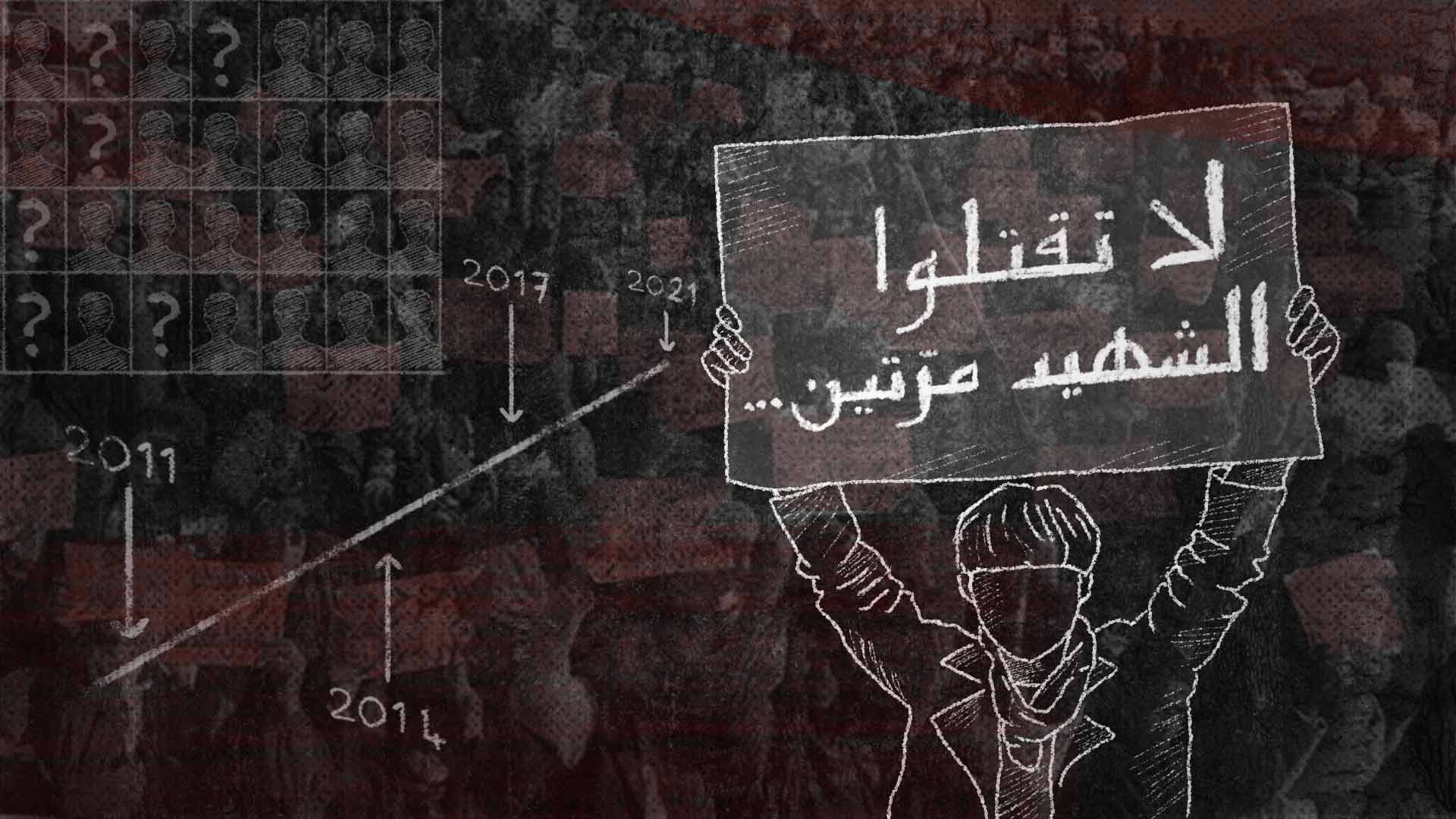FEBRUARY 18, 2011: INVESTIGATING ABUSES THAT TOOK PLACE DURING THE REVOLUTION
On February 18, 2011, one month after Ben Ali’s departure, the National Commission of Investigation (headed by Taoufik Bouderbala) was created through decree-law n°2011-8. The commission aimed to document the violations that took place during events of the Revolution.
2011: THE MINISTRY OF THE INTERIOR’S PROVISIONAL LIST
347 martyrs and 2749 wounded. In 2011, the Ministry of the Interior created a provisional list of martyrs and wounded of the Revolution. These numbers were subsequently used to distribute initial compensation to the main victims, but without legal basis since the official list was not yet final.
According to Yamina Zoghlami (a member of parliament who was part of the Commission of Martyrs and Wounded of the Revolution, responsible for creating the official list), the ministry obtained this data from the governorates themselves. According to the Zoghlami, this initiative was put in place when Béji Caïd Essebsi was Prime Minister, between February and December 2011.
OCTOBER 24, 2011: ESTABLISHMENT OF A SPECIAL COMMISSION FOR THE MARTYRS AND WOUNDED
The Commission of Martyrs and Wounded of the Revolution was established. Its objective: to draft and present an official list of victims from December 17, 2010 to February 19, 2011. During a Council of Ministers, then president ‘Fouad Mebazaa’ established the commission himself, through adopting decree-law No. 2011-97 himself. The commission is composed of 8 members, mostly from various ministries.
DECEMBER 24, 2012: AMENDMENT OF DECREE-LAW 97
A mere year later, Decree-Law 97 was called into question. According to Yamina Zoghlami, the Troika (the political coalition in power at the time), decided to amend it. According to Zoghlami, this was the initiative of Samir Dilou, who was head of the Ministry of Human Rights and Transitional Justice at the time.
From being a commission primarily composed of various ministry members, the members expanded as of 2012 to incorporate members of parliament and more people from civil society. Certain conditions for granting compensation to wounded and families of martyrs have also been amended.
The period in question was also extended from initially having been set from December 17, 2010 to February 19, 2011, it was extended to February 28, 2011 in order to include the Kasbah 2 protests.
During these protests, which lasted about ten days, demonstrators occupied the Kasbah square in Tunis, demanding the dissolution of the former regime, and the resignation of Mohamed Ghannouchi's government.
"At that time, there were numerous uprisings and instability, so it was difficult to take one's time, one had to react quickly because the street was buzzing. That's why several laws were rectified and modified later on", explains Elyes Ben Sedrine, former deputy director in charge of investigations at the Truth and Dignity Commission (IVD).
MAY 4, 2012: THE INITIAL ASSESSMENT
The National Commission of Investigation, established in 2011, delivers its report. The conclusion: 2147 wounded and 338 people killed, a slightly lower count than that provided by the Ministry of the Interior in 2011. "From this report, we [the members of the Commission of Martyrs and Wounded of the Revolution] have selected the people with the help of clear evidence and medical certificates", explains Yamina Zoghlami.
MAY 13, 2013: THE COMMISSION FOR MARTYRS AND WOUNDED COMMENCES WORK
Despite the initial assessment, the Commission did not actually commence work until the following year, two years after being established. Decree No. 2013-1515 from May 14, 2013 set the procedure: visits, statements, requests for official documents - they would have access to all the necessary information. However, the lengthy delay raises several criticisms.
"The commission started conducting medical examinations three years after the fact, [when] some traces no longer exist. When it's a bullet wound it's easier to prove, but when the person has been arrested, tortured, mistreated and assaulted, 3 years later there are no traces left", deplores Elyes Ben Sedrine.
Like him, several other members of civil society consider the official list to be incomplete, and denounce the commission's work process. Some say that they have not conducted any fieldwork or interviews with the people who are concerned. "Some of the wounded are not on the list, even though their trials took place in military courts and they obtained court rulings", explains Leïla Haddad, a member of parliament and lawyer in regular contact with the families of martyrs and the wounded.
Lawyer Lamia Farhani (head of the association 'Awfia'*), denounces the opacity of the commission, and the fact that it does not disclose any of its work:
"How was the list drawn up? What were the working conditions? This was all confidential. The work was confidential until the last minute", she says.
When confronted with these questions, Yamina Zoghlami explains that the commission members were afraid of having their work obstructed if they talked about it. "We were debating amongst ourselves whether to hold a press conference or not. We did not disclose [anything] because we were afraid that people would be unhappy and obstruct our offices", she explains.
Inkyfada contacted the president of the commission, Taoufik Bouderbala, several times. When he finally replied, it was to invoke a three-month confidentiality obligation, following the end of his mandate at the beginning of April 2021, preventing him from answering any questions.
DECEMBER 21, 2015: THE MARTYRS OF THE REVOLUTION ARE LISTED
The initial list is finally ready, naming the martyrs of the Revolution - however, it is not officially communicated or published. "The government decided to wait until the list of the wounded was completed before publishing it. There were several demonstrations held by the families of the martyrs who were not happy", says MP Leïla Haddad.
APRIL 2, 2018: THE OFFICIAL LIST IS FINALLY READY
It would take almost three more years for the commission to complete the work. As the final list was presented first to the President of the country, then to the Prime Minister, and finally to the President of the ARP (Assembly of the Representatives of the People), the publication was further delayed.
Subsequent governments continue to leave the file tucked away in a drawer, refusing to officially publish it - but why? Most members of civil society and politicians agree this is due to a lack of political will. "We were close to the elections and Youssef Chahed was afraid that the publication of this list would upset the wounded and families of the martyrs who are not on it. He wanted to run and so he refused to publish it", continues Leïla Haddad. "There was no political will. This issue has been badly managed by successive governments", confirms Yamina Zoghlami.
According to Elyes Ben Sedrine, claiming fear of criticism or protests if the list is published is merely the pretext. For him, "leaving people in limbo [by not publishing the list] is a way of not recognising the Revolution".
"The successive governments refused to recognise the Revolution because it directly implicated them. Some of them belonged to the old regime, so they are more or less complicit in what happened", he says.
OCTOBER 18, 2019: THE IVD (Truth and Dignity Commission) LIST IS PUBLISHED
In parallel, the Truth and Dignity Commission (IVD) published its own list of martyrs and wounded of the Revolution. Under Law No. 2013-53 from December 24, 2013 (on transitional justice), the IVD was tasked with documenting all human rights violations that took place in Tunisia between 1955 and 2013. Victims of the repression of the former regime who were wounded or killed during the events of the Revolution were therefore also included.
For Yamina Zoghlami, it was in no way the role of the IVD to draw up such a list, as this task was the exclusive responsibility of the Commission of Martyrs and Wounded of the Revolution. "Taoufik Bouderbala’s list is a legal and official list, the law of transitional justice does not require the IVD to make a list, it is a bonus. Why did they do it?" the MP asked. "The wounded and families of martyrs had to go to both the commission and the IVD, which confused them", she added.
For Elyes Ben Sedrine, the IVD list was conceived "to allow people to be patient because they were waiting for the publication of the official list". He assures that the IVD contacted the commission in 2017, but with no response: "We asked for access to the work of this body and the preliminary list to be able to coordinate our work and not end up with two different lists and dismissed people. This would have been more judicious", says Elyes Ben Sedrine.
"We were an official authority, so not responding to us is tantamount to a refusal. It's a refusal to work", he said.
"The Bouderbala commission was right in not responding to the IVD", said Yamina Zoghlami, arguing that the commission had already finished its work by the time of the IVD requests.
OCTOBER 13, 2019: THE OFFICIAL LIST IS PUBLISHED ONLINE
Taoufik Bouderbala eventually shared the official list on the website of the Committee on Human Rights and Fundamental Freedoms, which he had initially refused to do despite repeated requests.
Many wounded and families of martyrs subsequently discovered that their names were not on the list. However, they were unable to take legal action. "I explained to them that this publication had no official value and that they could not appeal on the basis of this", says Leïla Haddad.
DECEMBER 2020 - JANUARY 2021: THE WOUNDED AND FAMILIES OF MARTYRS OCCUPY KILANI'S OFFICE
For a whole month, several wounded people gathered with the families of martyrs to occupy the headquarters of the General Instance of Resistance fighters, Martyrs and Wounded of the Revolution and Terrorist Operations, chaired by Abderrazak Kilani. They were once again demanding an official publication of the list.
MARCH 19, 2021: THE OFFICIAL LIST IS PUBLISHED IN THE JORT
The official list of martyrs and wounded of the Revolution was finally published in the Official Journal of the Republic (JORT) by the government of Hichem Mechichi. It accounted for 129 martyrs and 634 wounded.
10 years after the Revolution, the wounded and families of martyrs whose names do not appear on the list can finally appeal to the administrative court, while the others can benefit from compensations and official recognition.
But the fact is that even after its publication, the list is still a topic of discussion. Some members of civil society point to the use of the term "martyr" instead of "victim". "This is not a juridical or conventional term, it automatically restricts the scope of application of this decree-law", says Elyes Ben Sedrine. Thus, this term effectively excludes people who were wounded or killed on the margins of the protests.
He explains that in other countries, the term "victims of human rights violations" has been used to recognise victims of revolutions as part of the transitional justice process, as "is the case in Libya".
Yamina Zoghlami believes that the role of the commission was to: "produce a list of people who participated in the Revolution and who chanted 'out with Ben Ali' or 'bread, water and no Ben Ali'".
For her, those who were wounded and the families of those who were killed on the margins of the protests who want to seek justice must turn to the courts, while "being a martyr or a wounded person is different. History must remember these people with a specificity", she argues.
But the problem of recognising victims is not limited to this narrow definition, for even when a wounded person or martyr fits the criteria, they may not be on the list.
This is the case of Jawaher and Ala, two activists who participated in the protests. In Kasserine on January 13, 2011, Ala was beaten by the police while Jawaher was shot (also by police officers), during the Kasbah 2 turmoil in Tunis. Both filed a complaint with the administrative court and have received no news as of yet. Neither of them have received any reason or explanation as to why they are absent from the official list.
"This dossier has gone through several authorities and administrations, but they have not coordinated, they all keep passing the torch", Lamia Farhani concludes.
The next episode will feature the stories of those left out of the list.




